Duomo Art Story | Location | Opening Hours Tickets | Authorizations
The Duomo of Milan in Italy
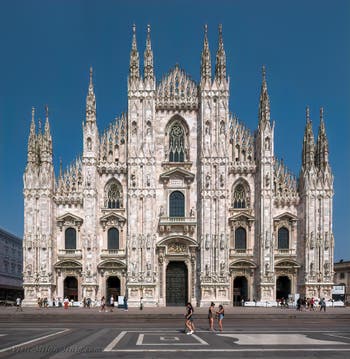
The Duomo of Milan's west facade Astonishing, majestic, magnificent, exceptional, these qualifiers are hardly enough to pay tribute to one of the most famous basilicas in the world.
The construction of the Duomo began in 1386 by the decision of the Duke of Milan, Gian Galeazzo Visconti, but was not completed until several centuries later.
Given its size and architectural and decorative elements, it is a colossal work with breathtaking numbers.
The figures of the Duomo of Milan
The external dimensions of the Milan Duomo
Outer length: 158 meters.External length of the transept: 93 meters.
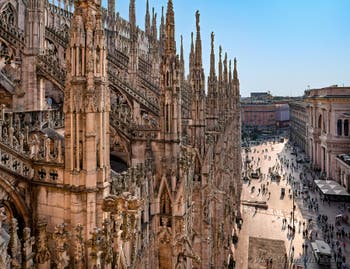
Duomo of Milan roof terraces and spires Width of the facade: 67.9 meters.
Maximum facade height: 62.2 meters.
Height of the Duomo, from the ground to the head of the Madonnina statue: 108.5 meters.
135 pinnacles and spires.
Surface of the Duomo: 12,000 square meters.
164 windows, including 55 stained glass windows representing 3,600 characters.
Total volume of the Duomo: 440,000 cubic meters.
The Internal Dimensions of the Milan Duomo
Internal length: 148 meters.Internal length of the transept: 89 meters.

Inside the nef of the Duomo of Milan Internal width of the four aisles, including the nave: 57.6 meters.
Height of the nave: 45.55 meters.
6,300 meters of marble ribs decorate the arches.
The total surface of the brick vaults is 9,350 square meters.
Useful interior surface: 8,000 square meters.
Internal volume of the Duomo: 280,000 cubic meters.
Excluding foundations, the Duomo structure, walls, vaults and statues represent 162,400 cubic meters for a total weight of 325,000 tons.
The sculpture of the Duomo of Milan
3,400 statues inside and outside the Duomo.Of which:
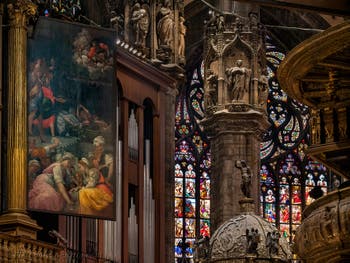
Inside the nef of the Duomo of Milan 96 giants and 150 gargoyles representing monsters.
410 statue corbels.
746 small corbels decorated with the heads of men or monsters.
The number of steps in the Milan Duomo
158 steps to reach the first roof-terrace.261 steps to the base of the dome or lantern.
500 steps to access the terrace at the highest spire.
But don't worry, if that's too much for you, you can take the elevator.
History of the construction of the Duomo in Milan

East Facade and Apse of the Duomo of Milan The Milan Duomo was built on an ancient sacred site dating back to Roman times.
A letter from Saint Ambrose, the famous bishop of Milan, mentions the presence of the Vetus Basilica on this site in the third century.
In the 4th century, the first cathedral in Milan was built, dedicated to Saint Thecla, with the adjacent Baptistery of San Giovanni alle Fonti, whose foundations were found under the Duomo and which can be visited.
A second cathedral, Santa Maria Maggiore, was built on the same site.
Finally, the church of San Michele subtus Duomo, “Saint-Michel by the Cathedral”, was erected on the site of the current transept.
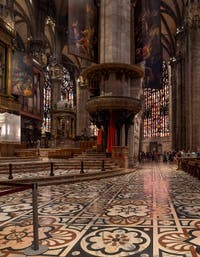
Inside the nef The bell tower of the Santa Maria Maggiore Cathedral collapsed in 1353.
A decree by Duke Gian Galeazzo Visconti appointed Simone da Orsenigo as general engineer, and construction of the current Duomo began in 1386.
After the death of Gian Galeazzo Visconti in 1402, French and German architects participated in the construction of the Duomo.
Still, they did not get along very well with Italian architects.
Among the architects whose traces have been found are those of the end of the 14th century, the Italians Andrea and Filippino da Modena, Zeno, Marco and Giacomo da Campione, and Giovannino de' Grassi.
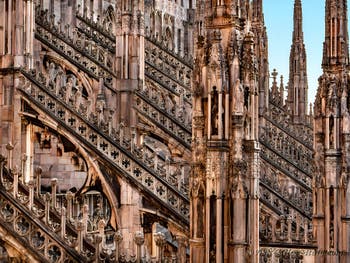
Duomo of Milan roof terraces and spires We will also mention the German architects Anichino de Alemania, Ulrich von Fuessingen and Heinrich III Parler, and French Nicola de' Bonaventura and Jean Mignot.
We find the same cosmopolitanism at the level of stonemasons, sculptors, carpenters and blacksmiths, with hundreds of craftsmen coming from Burgundy, Savoy, Provence, the Rhine Valley, Palatine, Swabia, Silesia, Prague and also Austria.
We can, therefore, see that as early as the 14th century, the construction of the Milan Duomo had become a large-scale European undertaking.
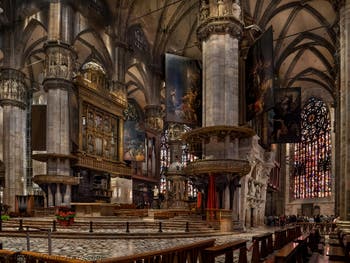
Inside the nef of the Duomo of Milan The Duomo construction site thus became a privileged place for the exchange of artistic experiences and cultures, unique at that time.
Because of this cooperation of architects, artists and craftsmen from all over Europe, the Milan Duomo can be described as one of the best examples of European Gothic cathedrals.
In 1404, the first spire rose to the northeast of the apse and was named “Marco Carelli” after one of the main sponsors of the Duomo.
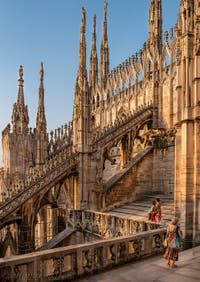
Roof terraces On October 16, 1418, Pope Martin V consecrated the main altar and the new cathedral.
During the second half of the 15th century, the Basilica of Saint Thecla and what was left of the Cathedral of Santa Maria Maggiore were demolished to be able to continue the construction of the Duomo on their site.
The marble of the Duomo in Milan
It should be mentioned that the marble used to build the Duomo came from the Candoglia quarries.The Duke of Milan, Gian Galeazzo Visconti, wanted the Duomo to be built only with that white and pink marble, with grey and beige veins that can be found exclusively in the Candoglia quarries near Lake Maggiore.
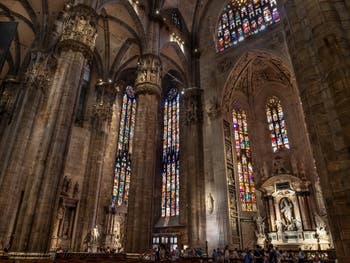
Inside the nef of the Duomo of Milan In addition to financing the construction at his own expense, the duke had exempted the extraction and transport of marble to Milan from taxes to ensure good supplies for the site.
The marble blocks were brought to Milan by water from Lake Maggiore, then over the Ticino River, and finally over the Navigli canals to the centre of Milan.
To guarantee the supply of marble until the construction of the Duomo was completed, Duke Gaelazzo Maria Sforza, the successor of the Visconti, donated the Candoglia quarries to the “Veneranda Fabbrica del Duomo” in 1473, where the marble was cut.
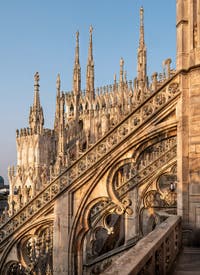
Roof terraces Several centuries were needed to complete the Duomo.
Almost all of the pillars raised in the aisles, their arches and the sculptures that adorn them, and the stained glass windows are still the original ones.
Some of the Lombard artists who have left us these masterpieces include Cristoforo de' Motis, Nicolo da Varallo, and Antonio da Pandino.
As early as the end of the 15th century, the dome lantern was installed on September 24, 1500, thanks to feasibility studies by Donato Bramante and Leonardo da Vinci.
They could then start building the upper part, the terraces that top the Duomo with their innumerable spires.
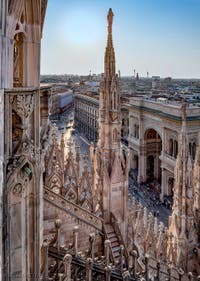
Roof terraces The first four spires were built around the lantern between 1507 and 1518, creating a central structure on which the highest spire of the Duomo was erected at the end of the 18th century to the glory of the Virgin Mary.
The work was significantly slowed down from 1522 to 1567, not only following the death of the architect and sculptor Amadeo but also because of an economic crisis that affected the entire duchy.
In 1567, thanks to donations from the Milanese and the important noble families, work resumed with the support and impetus given by the new archbishop of Milan, Cardinal Federico Borromeo.
A first Roman-style facade project was initiated at the end of the 16th century and abandoned in 1665 after the adoption of a new project by the architect Carlo Buzzi, which presented a Gothic-style facade.
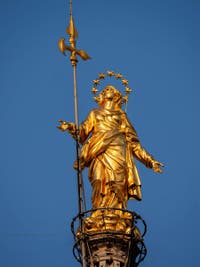
The Madonnina Work then slowed down again and resumed actively from 1765 to 1774 with the completion of the main spire and the crowning of it in 1774 with the statue of the “Madonnina”, the little madonna created by Giuseppe Perego and covered with copper and then gold by the goldsmith Bini.
Finally, on May 26, 1805, three days before being crowned King of Italy in the Duomo, Napoleon ordered the construction of the facade to be completed, which you can now admire.
The central bronze door, designed by Ludovico Pogliaghi, was installed in 1906.
Unfortunately, the air raids of August 1943 caused extensive damage to the Duomo; some spires and two marble portals on the south-facing facade were damaged, but everything has since been beautifully restored.
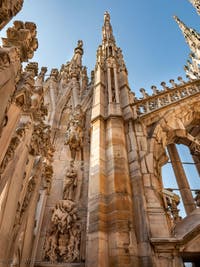
Roof terraces
The external sculptures of the Duomo in Milan
Four hundred twenty marble statues adorn the facade and sides of the Duomo.To these should be added the 1,900 statues of all sizes that decorate the 135 pinnacles and 410 spires.
And that's not all: 96 statues of giants support the Duomo's gargoyles.
Finally, most of the 746 consoles supporting the trilobed arches are sculpted and feature legendary human figures or animals.
The interior of the Duomo, Milan Cathedral
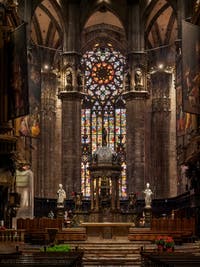
Inside the nef The Milan Duomo is a Latin cross with five naves up to the choir, where the nave is reduced to a single nave.
The Duomo faces east, as was customary for the first Christian churches whose choir was oriented towards the place where the sun was rising.
This perfect orientation allowed a bronze meridian to be embedded in the floor of the Duomo, a work carried out in 1786 by the astronomers of the Brera Observatory.
Marble pillars and columns
Fifty two 24-metre-high pillars support the cathedral's vaults.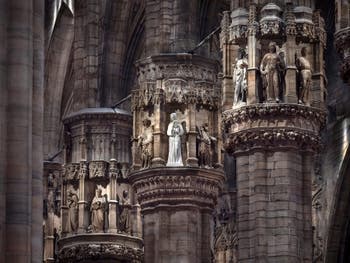
Marble pillars and columns of the Duomo of Milan Each of these pillars is composed of a large central column surrounded by eight other columns, four of which have a smaller diameter and are half sunk into the pillar to form an octagon with the others.
A 6-metre-high capital crowns each Gothic-style column with a diameter of 3.40 meters.
Imagine yourself inside the Duomo, surrounded by the thousand statues that decorate the interior.
Such abundance and architectural rigour in the design of this Milan Cathedral would, however, be nothing more than an accumulation of figures without the extraordinary artistic quality of the whole.
Your gaze rises to the arches of the naves while your feet obey only your eyes, eager to discover all the beauties surrounding you, the sculptures, the stained glass windows; everything is sublime and majestic simultaneously.
This Milan Duomo, capable of dazzling and moving you simultaneously, performs the miracle of making you feel all the power of human genius concentrated in an exceptional place.
Duomo Art Story | Location | Opening Hours Tickets | Authorizations
Back to Top of Page

